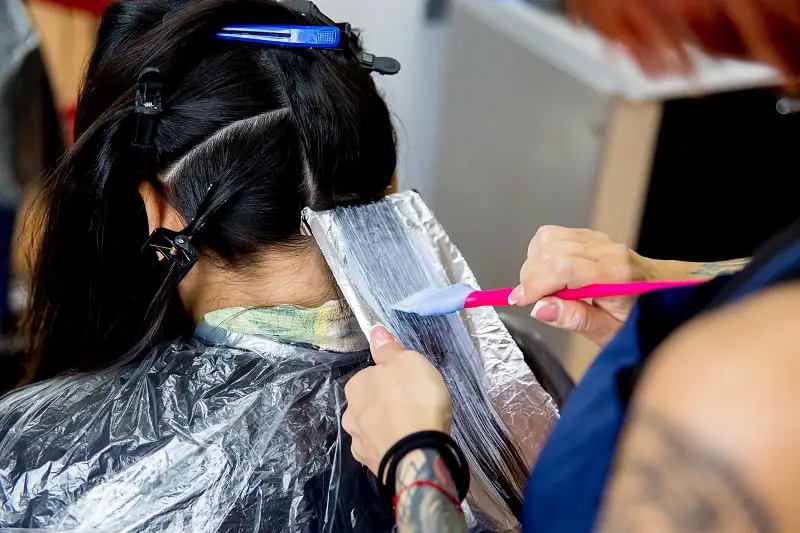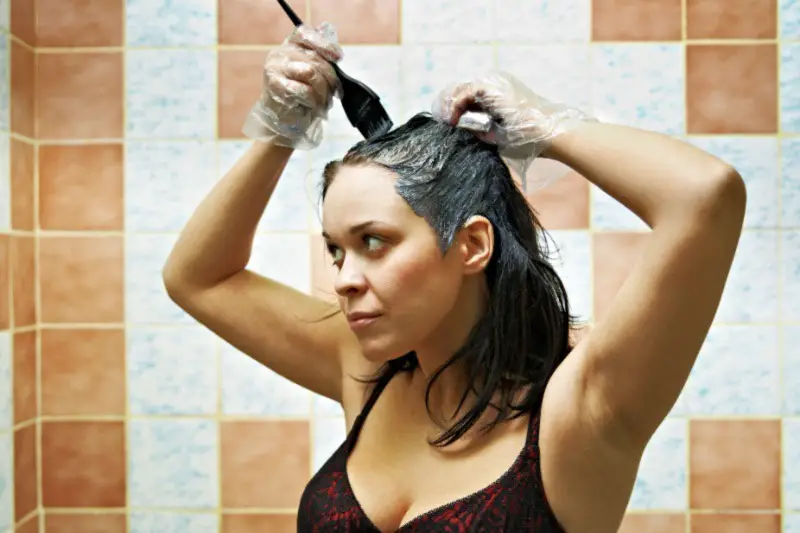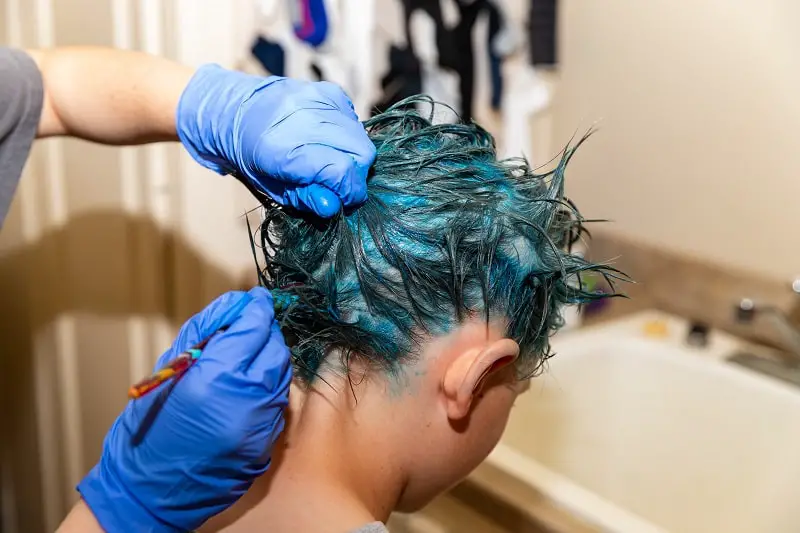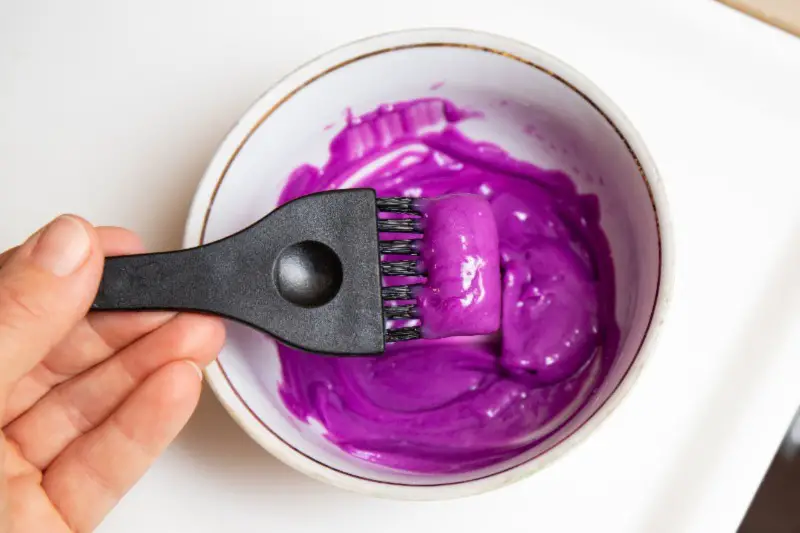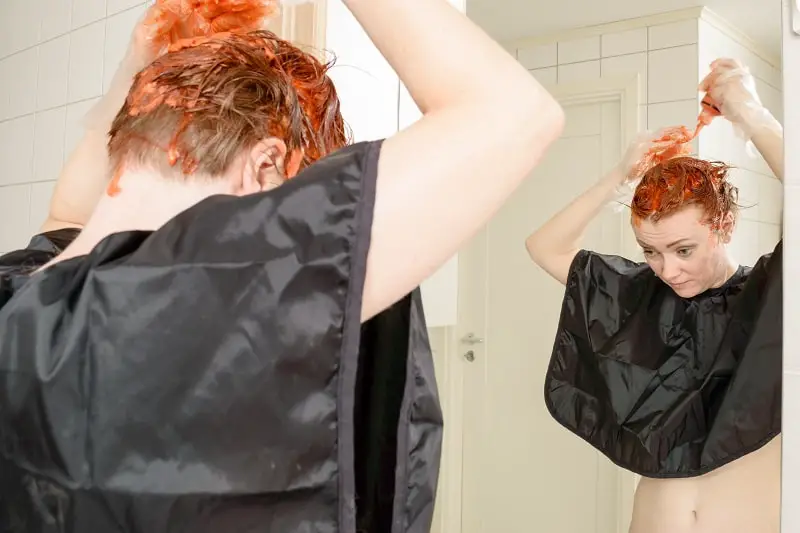“Can I use foils if I’m allergic to hair dye?” Unfortunately, there is no real easy answer here. The above question has haunted tons of folk in the past and, honestly, in the present too.
It’s a pretty scary thing, possibly putting your health on the line for a new ‘do, but what else can be done? It isn’t like you can simply just curb hair dye forever! Or … can you? To find out the truth, we encourage you to continue reading below.
This article will hopefully clarify some things regarding hair dye allergies while offering safe, effective alternatives in case you find yourself in the hair dye allergy boat.
Do You Need A Skin Test For Foils?
First things first: yes, you should do a skin test even if you are just using foils. Trust us on this. Using foil does not guarantee product from escaping and seeping out onto your scalp.
Trace amounts can still trickle out of the foil, causing an unintended allergic reaction when the product comes in contact with your skin. Now, nine times out of ten, you really don’t need a skin patch test unless you have hair dye intentionally coming in direct contact with your scalp.
Depending on foil placement and the exact style you are going for, you won’t need to test; so, if you are just dyeing the tips of your hair, you likely won’t have any contact allergy symptoms like dermatitis present.
However, it is always better to be safe than to be sorry: when handling a reaction that could be as severe as a nut allergy, performing a skin patch test beforehand is preferable.
This is especially true when faced with a suspected—or known—allergy to hair dye since the reaction can be promptly treated in a controlled environment.
What Are The Symptoms Of An Allergic Reaction To Hair Dye?
Symptoms of an allergic reaction to hair dye can manifest in a number of ways depending on the individual and the severity of their allergy.
The reaction can be immediately upon product contact with the skin or delayed, not showing up for hours—and in some instances days. The symptoms of an allergic reaction to hair dye can include:
- Redness and/or itchiness at contact site
- Rash-like inflammation
- Swelling of the eyes, lips, hands, feet, lips, or tongue
- Wheezing or difficulty breathing
- Nausea, stomach pain, vomiting
- Fainting
There are cases of individuals who regularly dye their hair and suddenly experience an allergic reaction. Research shows that the seemingly out-of-nowhere reaction can actually have been triggered from routine exposure.
What ends up happening is that the hair dye may have initially caused only a minor, excusable reaction before (if any), up until your body fully processes just what the heck happened and what it didn’t like about the product.
Most of the time, an allergic reaction to hair dye occurs as a sensitivity to paraphenylenediamine (PPD), one of the most common ingredients in hair dyes of today.
Do note that symptoms can manifest differently for each individual exposure. If you suspect you may be having a severe allergic reaction to hair dye, we recommend that you contact your local emergency response services.
What Is PPD?
PPD, known also by its lengthy name paraphenylenediamine, is a frequent chemical component used in hair dyes. It is thought to be one of the biggest factors behind hair dye sensitivities and a leading trigger of hair dye contact allergies.
Unlike other hair dye ingredients, PPD is not required to be approved by the United States Food and Drug Administration (FDA) since it is considered a coal-tar hair dye.
Can Highlights Cause An Allergic Reaction?
If the highlight product in question includes paraphenylenediamine, it is possible that it can cause an allergic reaction. Highlights require the use of foil, though foil does not promise to contain the lightening product.
Accidents do happen, no matter how unlikely they could be. In general, when applying highlights the goal is to get as close to the scalp as possible without causing banding—a halo-effect that occurs when there is layered and overlapped colored hair that creates a dark band around the head.
Ideally, 2 ½ to 3 inches away from the scalp is what to shoot for when applying highlights. While this may seem like more than enough space away from the scalp to curb an allergic reaction, remember that leakage is still possible.
As with all other kinds of allergens, it is best to avoid contact with them. Someone with a shellfish allergy wouldn’t make it a habit to order clams at a seafood restaurant, after all; nor would an individual that has an allergy to cats keep one as a pet.
Usually, at least. It is hard to say no to those little feline faces! Therefore, you should do your best to steer clear of highlights if you have an allergic reaction to hair dye.
There are methods and alternatives available if you still desire to color your hair after discovering your allergy, so you don’t have to give up a lovely new color forever!
How Can I Cover My Gray Hair If I Am Allergic To Hair Dye?
There are a number of options you can opt for if you are allergic to hair dye and are looking to cover some grays. In all, you can use color depositing products, PPD-free dyes, or take a more natural approach.
Below are all the alternatives to covering up gray hair if you are allergic to hair dye.
Depositing Conditioners
Color depositing conditioners contain small amounts of pigment inside the product that can be paired with a depositing shampoo to tint and add color to the hair strands.
Most of the time, depositing conditioners are used to touch-up the already present color by coating the hair in a temporary color. It enhances the current color.
Since this product deposits the color directly onto the strand rather than through a chemical process—and they do not contain PPD—they are oftentimes one of the safest options when looking for something to color your hair that won’t give you an allergic reaction.
Unfortunately, depositing conditioners (even when paired with a complimenting shampoo) aren’t necessarily the best for those searching for a blended, full-coverage color as one looking to cover up grays would desire.
They are effective, but only if you are looking for a minimal color shift. Colors from depositing conditioners tend to last only a short time—about a week or two—and don’t work for everyone.
You may have to hunt around for the perfect coloring product for you. Popular depositing conditioners include products by oVertone, Unicorn Hair, and Aura.
PPD-Free Hair Dye
The next option for covering gray hair is PPD-free dyes. Unlike depositing conditioners, PPD-free dyes can and will have full-coverage options. PPD-free dyes are—as one can assume by the name—completely free from the chemical paraphenylenediamine.
As is explained in Madison Reed’s 2017 article “All About PPD (And Why We Don’t Use It),” scientists have successfully created a low-risk imitation of the allergen, known as paratoluenediamine sulfate (PTDS) to replace PPD.
Not all brands have made the switch, making it vital to check the ingredients of a product before purchasing. Also, PTDS can possibly cause minor skin irritation if an individual does have a present allergy to PPD. This risk is low, and it is certainly not going to occur for everyone.
For some reference, PPD-free hair dye is available for sale by various hair color brands, including hair color brands Madison Reed, EcoColors, and Goldwell.
Coffees, Teas & Hennas
The following options are for those of you seeking an easy, all-natural approach to coloring your hair. As one can expect, these natural alternatives—coffee, tea, and henna—will not contain PPD.
Coffee Hair Dye
First of all, coffee is best used for getting a quick pick-up of energy in the morning … or anytime, really, if you can handle that sort of thing. Besides that though, coffee also works surprisingly well as a hair dye.
Pretty much, you will want to brew coffee with twice as much grounds than if you were making a cup for drinking. Then, let the coffee cool.
Mix the coffee with your conditioner and use it during your next wash as a leave-in conditioner. Then: boom. Easy natural hair dye that lasts three weeks!
Tea Hair Dye
Teas are accepted to be a gentler approach compared to coffee. Additionally, tea offers slightly more color variety since coffee is, well, coffee, and tea comes as black, green, white, yellow, oolong, etcetera.
Although there are a handful of methods that could be used when dyeing hair with tea, we will review the most common approach. What you would want to do is brew some tea of your choice: let it cool to room temperature.
Once the tea has thoroughly cooled, apply it to your hair with a color applicator. If unavailable, a fine-toothed comb will also work. Leave the tea on your hair for an hour before washing as normal. Tea hair dye will last about a week, perhaps two depending on the frequency with which you wash your hair.
Henna
Henna is great as an alternative to hair dyes. It is natural, richly pigmented, and comes in a number of colors. Popular for use in a paste form to celebrate weddings and other major life events, henna has been used for well over 5,000 years in a number of countries and continents across the world.
Its ability to naturally stain the skin and a variety of fabrics means that it is also very effective as a hair dye. Evidence of henna being used as a hair dye dates back to ancient Egypt, making henna hair dye far from a new development.
Meanwhile, henna hair dye lasts about 6 weeks: far longer than the other offered natural alternatives. Brands to keep an eye out for if you are interested in henna include Khadi, The Henna Guys, and Reshma.
How Can I Color My Hair If I Am Allergic To Hair Dye?
If you are allergic to hair dye but still desire to color your hair, seek out a PPD-free coloring product, natural coloring alternatives, or depositing shampoos and conditioners.
All of these can be reviewed in full above, as listed in “How Can I Cover My Gray Hair If I Am Allergic To Hair Dye?” For a quick refresher, you want to more or less stay away from any product that contains the allergen PPD.
If you are looking to majorly switch up your color, we would suggest looking into PPD-free dyes and henna-based dyes since they are the strongest, most pigmented of the bunch. Otherwise, coffee, tea, and depositing washes are fantastic for more subtle shifts.
What Hair Dye Can You Use If You Are Allergic?
Being completely honest: hair dye is already a challenge to figure out, let alone if you are allergic to it. It won’t matter if you’ve found the perfect color-match from your latest inspiration pic, because you won’t be able to use it!
Considering if you have a contact allergy and sensitivity to standard hair dye, select a non-toxic, PPD-free formula. Better yet, if that is deemed even too risky, natural dyes can work just as well.
Final Thoughts: Can I Use Foils If I’m Allergic To Hair Dye?
To wrap everything up nicely, let us touch on the major takeaways you should be getting from this article. First, hair dye contact allergies are incredibly common.
Which in hindsight, is a bit of a good thing: it means there is a selection of alternatives to choose from and the phenomena has been studied.
Hair dye allergies are primarily caused by the body negatively interacting with—and ultimately rejecting—a chemical in the dye called paraphenylenediamine (PPD).
Here, the good news is that there is an alternative to PPD called para toluenediamine sulfate (PTDS), which replaces the allergen while offering the same bonding effects. Bad news is that it may still cause minor dermatitis, but nothing as severe as a contact reaction to PPD.
Alternatives, again, are a life-saver here. There are entirely natural options like coffee, tea, henna concoctions available, or there are things like depositing shampoos, conditioners, or simply PPD-free dyes.
Now, if you are looking to cover grays but have a dye allergy, any of these can work for you, depending on the extent of which you are trying to cover the silvery strands.
For example, deposits and remedies made from coffee or tea won’t cut it for full-coverage. That being said, henna dyes and dyes that are PPD-free are effective for that sort of thing.
Last of all, remember that allergies exist for a reason. Something about the allergen is being outright rejected by your body on a chemical level. It is best to not force contact as the impending reaction can grow with severity each exposure.

